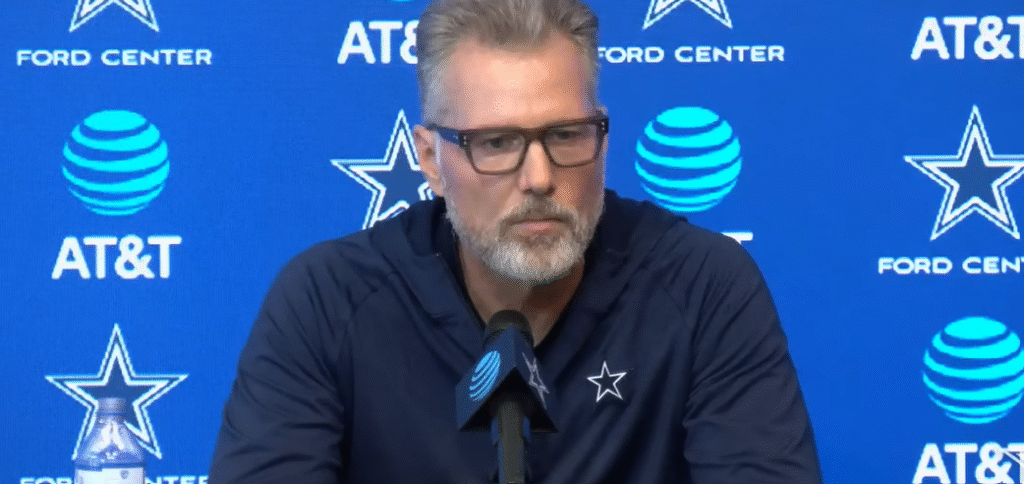Matt Eberflus has established a solid reputation for organization, responsibility, and unwavering drive. His defensive strategy, which is currently being scrutinized in Dallas, demonstrates a methodical approach based on the principles but modified for contemporary football. However, this season has become a crucial test of his leadership and strategy due to the conflict between philosophy and execution.
Eberflus has a reputation for turning ineffective defenses into productive, turnover-driven teams over the last ten years. The HITS principle—Hustle, Intensity, Takeaways, Smart Play—is the foundation of his coaching identity. It’s a motto that promotes effort in every snap and accuracy in every read, fostering a team discipline that, when properly applied, can be incredibly successful in limiting big plays and producing turnovers that change momentum.
However, that structure is beginning to show signs of strain as the Cowboys navigate a rocky start. With missed assignments and coverage breakdowns resulting in lengthy completions and easy scores, the team currently ranks close to the bottom in a number of defensive categories. Unquestionably, the numbers are harsh: last in total yards conceded and 31st in points allowed. These figures highlight how communication breakdowns can cause a complex system to fall apart, a problem that Eberflus’ players have freely admitted.
Table: Matt Eberflus – Coaching Profile
| Category | Details |
|---|---|
| Name | Matt Eberflus |
| Birth Year | 1970 |
| Current Role | Defensive Coordinator, Dallas Cowboys |
| Past Roles | Bears Head Coach; Colts Defensive Coordinator; Cowboys LB Coach/Passing Game Coordinator |
| Defensive Philosophy | Emphasis on takeaways, stopping the run, “bend-but-not-break” principles |
| Base Front | 4-3 base with zone-heavy back end |
| Key Mantra | HITS (Hustle, Intensity, Takeaways, Smart) |
| Strengths Historically | Top-10 takeaways, run defense improvements |
| Challenges in 2025 | Communication breakdowns, coverage errors, adjusting to new scheme |
| Reference | Dallas Cowboys “What Does Eberflus’ Defense Look Like?” Dallas Cowboys |

The Cowboys’ locker room has been a place of both resoluteness and frustration in recent days. Trevon Diggs and Kaiir Elam, two defensive backs, have been open about the importance of “trusting the system” and paying attention to the little things. This idea—accountability through clarity—has become especially important in a plan where a single misunderstanding could jeopardize the defense as a whole.
Eberflus’ strategy differs significantly from the combative, man-heavy approach that was previously preferred by Dan Quinn. His zone-based system isn’t just meant to respond to plays; it’s meant to predict them. Instead of depending only on pressure, it seeks to generate opportunities for takeaways by using spatial awareness and making quarterbacks make accurate throws. Nonetheless, the Cowboys’ zone coverage percentage has skyrocketed to almost 87%, the highest in the league, a statistic that highlights the dangers associated with his philosophy as well as its consistency.
Cohesion is necessary for the reliance on zone defense, and coverage assignments can quickly fall apart in the absence of strong back-end leadership. Receivers frequently ran uncovered through the secondary during the Carolina loss, which is indicative of timing misalignment rather than schematic failure. “You have to communicate with confidence — softly spoken defenses don’t survive in this league,” Eberflus said in postgame interviews. Despite being figurative, his point captures a real reality: his defense depends on accuracy and judgment rather than improvisation.
Through a more aggressive integration of defensive linemen into gap control, Eberflus highlights a strategy that starts at the line of scrimmage. Often referred to as the “engine” of his system, the three-technique tackle acts as a catalyst for containment and pressure. Effective performance in that role by players like Osa Odighizuwa makes the scheme work like a synchronized mechanism, which is extremely effective and challenging to control.
But when the front doesn’t produce steady disruption, the weaknesses resemble those that beset his time in Chicago: slow rotations, open seams, and delayed reactions. Eberflus, however, is adamant that the blueprint itself is effective. He has stated time and time again that players must internalize the system’s discipline for it to work; the system does not fail them.
There will inevitably be comparisons to Dan Quinn’s strategy. Quinn’s Cowboys were notoriously aggressive and unpredictable, relying on one-on-one coverage confidence and blitzing frequently. Eberflus, on the other hand, concentrates on structure and leverage while building through methodical containment. Although this philosophical difference has generated discussion among analysts, Eberflus maintains that patience is an indisputable virtue.
The head coach of Dallas, Brian Schottenheimer, is still defending his coordinator. His insistence that the defense is “ten to fifteen percent away from execution perfection” is not a sign of blind loyalty, but rather of cautious optimism. According to reports, the two have devoted many hours to going over coverage tapes in an effort to streamline calls and restore player confidence. Their cooperation, which is particularly transparent and critical, reflects the constructive dialogue culture that contemporary NFL coaching is progressively embracing.
In contrast, Eberflus’ philosophy is reminiscent of coaches like Rod Marinelli and Tony Dungy, who preferred responsibility-based plans over chaos-driven aggression. The way that this lineage values mental processing and reaction time is especially novel. The goal is to win precisely, with each defender knowing not only where to be but also why, rather than to overwhelm opponents with volume.
It can be mentally taxing for players to adjust to that framework, which is heavily reliant on logic. It frequently takes younger athletes more time to learn route recognition and spacing dynamics. However, the rewards can be remarkable once internalized. The combined effect of alignment, awareness, and anticipation is demonstrated by the 88 turnovers that Eberflus’ defenses forced over three seasons while he was in Indianapolis.
Aligning that same mindset with players used to autonomy is a challenge given Dallas’ all-star roster. One of the league’s most versatile defensive players, Micah Parsons, personifies that shift. Moving between edge rushing, spying, and coverage assignments, his role under Eberflus has become incredibly versatile, demonstrating the system’s inherent flexibility and trust.
However, not every experiment produces results right away. The defense’s inability to stay cohesive under pressure has been compared to other transitional periods in sports. The initial chaos followed by eventual mastery once players fully assimilated the tactical language is reminiscent of Pep Guardiola’s early days at Manchester City. The same idea might hold true in this case: knowing the “why” behind Eberflus’ calls could ultimately help the system reach its greatest potential.
